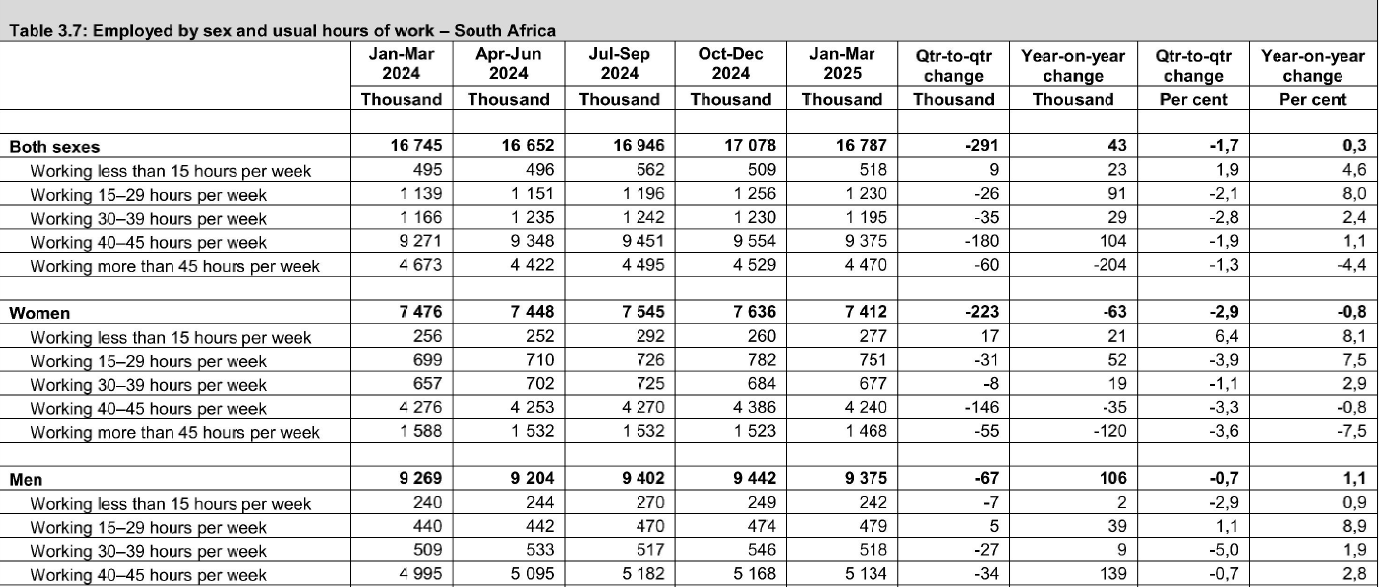It happens from time to time that someone questions the integrity of the survey methods and accuracy of the figures produced by Statistics SA. The result is always the same – the head of Stats SA comes out all guns blazing to prove the statistical validity of his team’s work.
The most recent debate around Stats SA’s figures erupted when Capitec CEO Gerrie Fourie remarked that the unemployment rate in South Africa could be as low as 10%. Stats SA sticks to its estimate of an official unemployment rate of nearly 32.9% – and the expanded unemployment rate of 43.1%.
Fourie argues that Stats SA does not count everyone who is working in the informal sector.
His view is probably influenced by the fact that Capitec has 24 million clients.
He noted that nearly three million of Capitec’s clients earn an income without formal employment, and more than one million use their bank accounts to operate a small business.
Fourie says the data suggests that some four million people are earning an income in the informal sector.
In addition, the latest figures from the different banks in SA show that Standard Bank has around 12 million local clients, Absa has 12.7 million, FNB has 8.6 million, and Nedbank has 7.6 million. TymeBank states that it has 10 million clients.
The total comes to nearly 75 million. It raises the question of why anybody would need a bank account – and apparently multiple accounts at more than one bank – if they don’t have money or don’t earn money somehow.
Perhaps these figures support Fourie’s argument.
ALSO READ: Is South Africa’s unemployment rate really only 10%?
Not so, says Stats SA head
But the Capitec CEO received more criticism than support. Statistician-General Risenga Maluleke issued a statement saying that Stats SA does measure the informal sector.
“The informal economy is not ignored,” says Maluleke.
“Stats SA produces several statistical products that measure this sector, including the Quarterly Labour Force Survey (QLFS) and the Survey of Employers and the Self-Employed. The informal sector is measured, tracked and reported on consistently. Stats SA follows the guidelines set by the International Labour Organisation (ILO) for defining the informal sector, which is characterised primarily by the registration status and size of enterprises or businesses.
“Our methods stand open to rigorous examination, inviting scrutiny to ensure integrity and trustworthiness.
“The data we produce is publicly accessible, fostering a culture of openness,” he adds.
ALSO READ: Minister agrees unemployment statistics should include work in informal sector
“Our concepts, definitions and classifications are meticulously crafted, guided by the highest global standards and best practices. We take pride in our commitment to transparency, clearly articulating what we measure, and the methods employed to derive our insights.”
Maluleke appeared on national television to assure people that the statistics are accurate.
He took Fourie on: “If he says unemployment is sitting at 10%, it means 10% of 25 million, we’d have 2.5 million people who are unemployed in South Africa and then it means that we have 22.5 million people who are employed. The Sars [South African Revenue Service], from personal income tax doesn’t even have such numbers for starters.”
He says it is incorrect and misleading to suggest that Stats SA somehow “misses” those who are employed in the informal sector.
The latest QLFS for the first quarter of 2025 estimates the working age population at 41.7 million of which slightly more than 25 million are considered to be in the labour force. The rest of the people are not working and not looking for work, including those still at school or studying, in jail or those who have a (wealthy and generous) spouse or family to provide for them.
Around 16.8 million are classified as employed, including 3.3 million in the informal sector and more than one million in private households (domestic workers and gardeners). That leaves 8.3 million unemployed and looking for work.
There are another nearly 3.5 million people who are classified as discouraged workseekers. The Stats SA report defines a discouraged workseeker as “a person who was not employed during the reference period, wanted to work, was available to work or to start a business, but did not take active steps to find work during the last four weeks” preceding the date of the survey.
ALSO READ: Unemployment underscored by weak economic activity – 1 in 3 unemployed in SA
The employed, by gender and hours of work

How Stats SA gets its data
Stats SA says its sampling method is statistically correct and representative. The QLFS surveys households directly and collects information from approximately 30 000 dwelling units. It collects data on the labour market activities of all individuals aged 15 years and above in the selected dwellings.
Desiree Manamela, chief director of labour statistics at Stats SA, says data collectors visit the selected dwelling units once every three months and interview all the people residing in the dwelling.
“There can be multiple households within a dwelling unit. Everybody in those households will be interviewed,” she says.
“The survey is structured in such a way that we don’t simply ask people whether they are employed or unemployed. There is a series of questions that we ask people within households and then we analyse the answers based on international standards to classify them according to different labour force statuses – meaning individuals are classified into three mutually exclusive and exhaustive categories following ILO hierarchy.
“We have employed persons, we have unemployed persons, and we have people that we call inactive. These three labour market statuses are supposed to sum up to the working age population,” she says.
“Employment takes priority over unemployment, and unemployment takes priority over inactivity. The first status that we derive is employment.
“We first want to know, of the people who are in the working age population, how many are employed. Then, once you have classified the people that are employed, we move on to the next status, which is unemployment. Now we ask people questions where we are going to classify them into the unemployed or the inactive. Unemployment will take priority over inactivity.”
ALSO READ: ‘Government initiatives alone can’t address SA’s unemployment rate’
Odd jobs regarded as employment
It is quite a lengthy questionnaire that collects a lot of data.
One should keep in mind, though, that the questionnaire has been designed to ensure that, based on individual responses, respondents are only asked questions that are relevant to them.
Questions are arranged in six sections totalling approximately 30 pages.
The questionnaire starts by identifying the respondents and covers basic aspects such as age, population group, sex, marital status, and education.
The questions on employment details are asked of all persons aged 15 years and above who indicated that they did work for pay or profit – even if a person worked only for an hour during the week preceding the interview – or if they were temporarily absent.
Odd jobs for payment and even unpaid work in a household business is regarded as employment. Stats SA asks about the type of work, main tasks at work, working hours, type of business, type of products produced, income, and participation in public work programmes.
ALSO READ: Economy sheds jobs again in first quarter, unemployment worse than year ago
The QLFS collects data on how many people worked and for how many hours.
A single hour of paid work during the past week classifies a person as employed.
Some employed persons may report that they would like to work additional hours if the extra hours are paid. This information assists in deriving persons in time-related underemployment.
The QLFS report for the first quarter of 2025 discloses that of the 16.8 million employed persons, only 9.4 million work a standard work week of 40 to 45 hours.
Approximately 518 000 “employed” persons worked less than 15 hours a week.
Stats SA measures this time-related underemployment by the more than 781 000 workers who said that they would like to work more hours for additional pay.
We asked Manamela for a simple explanation of these statistics to confirm the information. “We don’t say a person who is working 40 hours a week is employed and somebody who is working only 20 hours is half-employed. You are either employed, unemployed or inactive; and for those employed, if they work less than 35 hours a week and are available and want to work more hours, then they are regarded as underemployed,” she says.
These statistics prove Fourie wrong. If anything, most people may actually think that Stats SA is underestimating unemployment.
ALSO READ: SA youth not unemployed, rather under-employed
People lie or leave out information
There is also the possibility that the respondents in the survey are lying to the data collectors when asked whether they are employed.
There are many reasons to lie, including those among the 18 million social grant beneficiaries who also work a day or two per week.
Evading income tax is another reason to lie.
And criminals wouldn’t be honest. Robbery, hijacking, drug dealing, cigarette smuggling, rhino poaching, investment scams, and prostitution generate an income, but these ‘self-employed workers’ won’t reveal their employment status. They simply bank the cash quietly.
This article was republished from Moneyweb. Read the original here.














